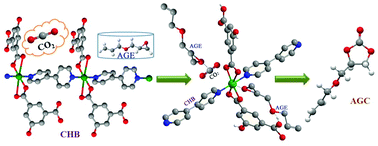Aqueous-microwave synthesized carboxyl functional molecular ribbon coordination framework catalyst for the synthesis of cyclic carbonates from epoxides and CO2†
Abstract
A carboxyl-containing coordination polymer catalyst {Cu(Hip)2(Bpy)}n (CHB) was synthesized rapidly in an aqueous medium using microwave energy and characterized for its structure, morphology, acid-base sites and heterogeneity using experimental and physicochemical techniques. The microwave route was established as competent with the hydrothermal pathway. Exploration of the coordination modes of metal–organic framework (MOF) ligands, especially carboxyl spacers, in achieving reactive functional groups is herein illustrated as crucial rather than focusing merely on the porosity of MOF catalysts. The work represents the first report of a carboxyl-containing MOF class material employed for synthesizing cyclic carbonates from epoxide and CO2. The metal–carboxyl mediated cycloaddition of allyl glycidyl ether and CO2 by the cooperative influence of Cu2+ and the COOH of CHB was synergistically enhanced by an ionic liquid co-catalyst to obtain allyl glycidyl carbonate in 89% yield at optimised reaction conditions. The epoxide substrate scope, effect of reaction parameters and catalyst recyclability (up to 5 cycles) were also studied.


 Please wait while we load your content...
Please wait while we load your content...